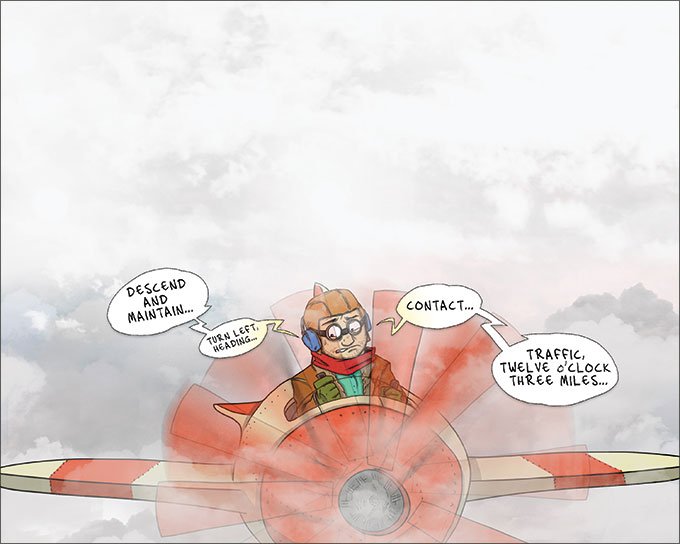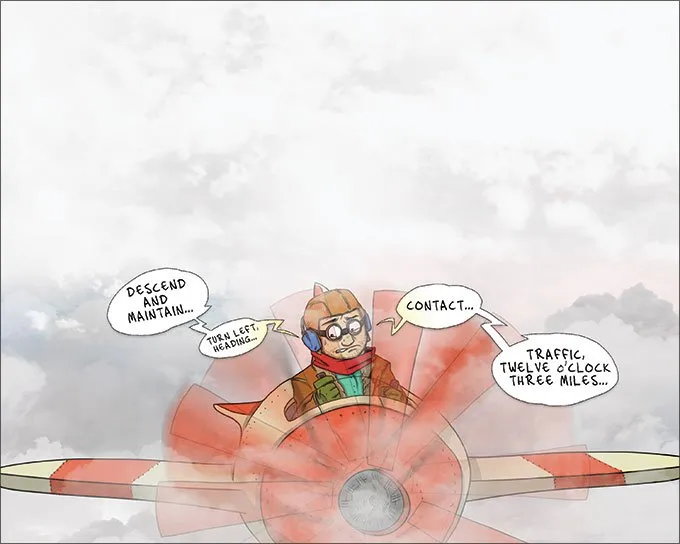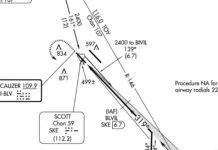Just north of Tampa Bay I switched to Miami Center. I was instantly assaulted with the continuous barking of an auctioneer. The controller took a breath so I checked in. He ignored me. Instead of flying off the coast, I’d already been rerouted over Georgia and western Florida for growing thunderstorms and active military airspace. Thunderstorms were worsening, funneling everyone into the few remaining clear alleyways.

I tried to check in, unsuccessfully, a couple more times and even tried my previous frequency only to be told the obvious—it was busy. Deviating with no radio contact in a hornet’s nest of TCAS traffic symbols was unsettling. Finally, ATC called me, “contact Miami twenty-four thirty-seven.”
Controllers have a strategic perspective supplementing the tactical view pilots get out the window and from the instruments. But, ATC also has requirements, procedures, and techniques of their own. ATC is usually a great resource. To get the most of this resource a pilot must realize the pressures controllers’ face, when they are susceptible to errors, and how pilots can improve communication.
A controller has two primary responsibilities, separating traffic and issuing safety alerts. Secondary responsibilities include, filing flight plans, amending flight plans and VFR radar advisories. At a busy facility, controllers continually evaluate their workload. If they devote too much time to lower priority tasks, they can quickly become overloaded and make mistakes.
Watch Out
People can only accomplish so many tasks before unnoticed and uncorrected errors creep in. The most serious controller error is a loss of separation. Weather deviations and training increase workload dramatically. As this paraphrased ASRS report shows, an error can occur in a split second:
I was conducting training. There were a lot of weather deviations. The problem started when aircraft X at FL200 deviated more than expected. The R-Side saw this, and I mentioned that there might be a problem soon. At that time, a tracker sat down producing about a 15 second distraction. Almost immediately the tracker told the R-Side to descend aircraft Y. Since it was already climbing through FL192 it reached FL198 before it began descending to FL190. They said they were responding to an RA. Separation was regained as they reached FL190. The sector wasn’t in full control briefly after that because they were a bit shaken up from the loss of separation.
Pilots should recognize when a controller is saturated and we should use other resources to back-up our situational awareness. Be aware of potential threats and be prepared to respond.
At night, in weather, dark terrain is difficult to see. ATC usually does a good job keeping us clear of terrain, so we can get complacent about it. In this example, a read-back error went uncaught because of training and high task loading.
I did not hear the E135 read back an assigned altitude of 3000 in an area of 3500 MVA. My trainee initiated a frequency change of the B757 to tower with insufficient wake turbulence spacing. I called Local Control to initiate a go-around. My trainee then noticed the E135 at 3,000 and issued a climb. I then issued an “expedite climb” to the E135. The audio data indicates that the Feeder Controller assigned the E135 5000 but the pilot read back 3000.
Minimum vectoring altitudes, MVAs, are similar to MSAs in that they generally provide at least 1000 feet of obstacle clearance. But, MVA areas can be much smaller and some can therefore be lower than the overlying MSA.
Unfortunately, MVA charts aren’t easily available in the US, leaving pilots to use other means to cross-check. Nav charts provide some terrain awareness, but a GPS-driven terrain database is best. Familiarity with ATC procedures also helps us know when something is wrong. For example, ATC will usually vector you onto final a few miles outside the final approach fix. If you’re way past the fix without a base turn and no conflicting traffic, it is time to speak up.
To expedite the flow of traffic between adjacent facilities, local procedures are developed and documented in Letters of Agreement (LOA). An LOA may require every aircraft arriving from one direction fly over a specific fix or be at a certain altitude. In busy airspace, such as from Philadelphia to Washington, DC, these LOAs are often worked out among multiple facilities.
LOAs standardize procedures and can reduce a controller’s workload but they are not set in stone. Time permitting, a willing controller can call the next facility and work out something different. Also, controllers issue instructions that are most convenient for them. If those don’t work for you, offer some alternatives, but be sensitive to the controller’s workload before asking for too much—it’s a waste of valuable time and you won’t get it anyway if the controller is saturated.
It Goes Both Ways
A pilot can, hopefully inadvertently, muck up a controller’s plans. I was once flying from Chico to Redding, California. Weather was marginal as I taxied out and picked up my clearance, which included an EDCT (Expect Departure Clearance Time). I didn’t want to wait and told ground to cancel my clearance. I took off VFR and tried to pick up a clearance in the air, believing the delay was due to inbound aircraft.
After scud running out of Chico, I called Approach. The controller wasn’t happy because the delay was due to traffic into Redding. I didn’t realize both airports were in the same sector, meaning it was the same controller who gave me the EDCT. Fortunately, the controller worked me in without giving me a phone number to call.
If I thought about it, I could have asked the reason for the hold. If it was for traffic into Chico, my plan was sound. If I knew the delay was for traffic into Redding, I would have shut up and waited.
Communication is central to the pilot/controller relationship. Misuse of terms, such as minimum fuel, leaves controllers guessing what pilots mean. The Pilot-Controller Glossary defines minimum fuel as “.. an aircraft’s fuel supply has reached a state where, upon reaching the destination, it can accept little or no delay. This is not an emergency situation but merely indicates an emergency situation is possible should any undue delay occur.” Yet many pilots believe declaring it entitles them to priority.
Minimum fuel is not an urgent or distressed condition, but a precursor. Ideally, it gives a controller warning to be ready with a clearance to an alternate if a delay arises at the destination. The following ASRS report highlights a breakdown in communication.
As the 2 aircraft began to compress on final…I canceled the Learjet’s approach clearance and issued control instructions to ensure separation was maintained. The Learjet replied to my cancellation of his approach with “unable.” I later learned he declared minimum fuel with Center.
While on the approach, the Lear had not yet experienced an undue delay and should have had enough fuel. That go around might result in an emergency then requiring priority handling.
Controllers are not mind readers and are liable to be scrutinized for giving non-emergency aircraft priority or special handling.
The “E” Word
Pilots are far too reluctant to declare an emergency. This hinders our ability to effectively harness ATC resources. In the following paraphrased report, a pilot repeatedly refused to declare an emergency while deviating from his IFR clearance.
Reaching 5000 feet the pilot said he was picking up severe icing and needed to get lower. I gave him 4000 feet and asked if he wanted to divert. He said he wanted to and I cleared him to ZZZ airport with a vector to intercept the ILS approach. He descended to 3400 and I told him to maintain 3,700. He said he was having difficulty and I asked if he was declaring an emergency. He said no and said that he saw a hole and wanted to descend down through it. I asked if he was declaring an emergency and he said no. Being that he was unable to maintain altitude and fly assigned headings while still on an IFR flight plan I told him I was declaring an emergency for him and altitude was his discretion.
The controller provided the pilot with an extraordinary amount of assistance that wouldn’t be possible without an emergency. Declaring an emergency focuses the resources of the facility to free the controller to devote full attention to the emergency aircraft and coordinate the necessary resources.
Pilots should not be reluctant to declare an emergency. Emergencies do not always require paperwork. If priority or special services are provided, ATC may ask for a report documenting why, simply to protect the controller. Also, emergencies may not last long. For example, carburetor icing may cause an emergency inability to maintain altitude. Once the ice melts and power is restored at a lower altitude, there is no reason the emergency can’t be cancelled and the flight cannot continue, as long as the decision is based on sound judgment about conditions ahead.
Since Archie League became the first US air traffic controller in 1929, ATC has played an important role in aviation safety. Instrument flying in particular is a dance between pilots and controllers. Controllers do a great job but have limits. Training and weather cause high workloads and increase the chance for errors. A prudent pilot pays particular attention to his surroundings during these times.
Also, controllers must coordinate with other ATC facilities, typically through LOAs. From a pilot’s perspective these can cause circuitous routings and undesirable altitudes. A little negotiation might sometimes get you what you want. But, we pilots also have to do our part. Ask questions and understand the AIM and Pilot/Controller Glossary. If immediate assistance is needed, declare an emergency so the controller can harness all of his resources. The air traffic control system is one of a pilot’s best tools. To effectively use it, we must understand its strengths and its limitations.
But, I’d still like Miami Center to acknowledge my check-in.
ATC Too Helpful, Or Not Enough?
Commercial operators can’t accept an instrument approach clearance unless the reported visibility meets the approach minimums. Once the approach has begun—inside the FAF—it may continue regardless of the reported visibility. This produces a few “wink-wink” moments when the visibility is sufficient for an approach clearance, but the controller overlooks it a moment later when it’s back down and the plane isn’t yet inside the FAF.
Since many commercial operators have different capabilities, a controller will often ask a pilot what they need for the approach. Then magically the controller reports the required visibility and clears you for the approach. While this seems gratuitous, and might occasionally be, apparently the intensity of the lighting systems can sometimes affect the RVR reading and turning up the lights can briefly improve the reported conditions. Nice trick if everyone’s on the same page.
We needed 1600 RVR one day, but it was stubbornly between 1200 and 1400 while we were getting routed all over creation waiting for an improvement and for our sequence. As we were at last being vectored to final, the controller, knowing we needed 1600, reported 1600—whether it was actually 1600, or he made it up, or momentarily turned up the lights to get a better reading, I’ll never know—and cleared us for the approach. A moment later he handed us off to tower, but they didn’t get the message.
As I checked in, still outside the FAF, as was common, tower cleared us to land and reported 1400 RVR. “Dude! Why’d you have to tell me that?” I thought to myself. Since we were still outside the FAF, I looked over at my first officer, we simultaneously uttered an expletive and I declared a missed approach. The weather gradually got lower and we diverted to the alternate, only returning about four hours later. —FB
Covering Your Assets
Air traffic controllers are trained to respect the dangerous nature of aviation. If we make a bad call, someone could get scared, hurt, or—worst case—might not come home. To keep our traffic safe and our own butts out of hot water we constantly ask ourselves “What if…?”
The ATC rule book is full of actions ATC is absolutely required to perform, and others to be accomplished with available time. Since we’re not the pilot, we frequently provide pilots with pertinent flight information and options.
Take, for example, wake turbulence. If a Cherokee is right in line behind a departing heavy 767, I can’t assume the Cherokee pilot noticed the 450,000 behemoth. I am still required to hold him two minutes after the heavy and include “caution wake turbulence” in his takeoff clearance. If I don’t and the Cherokee crashes, at least part of the blame could fall on me.
So, I follow the rules, ever mindful of the Cherokee pilot’s life and my own career.
What if my workload is low, I don’t tell a pilot about severe weather, and the storm swats him from the sky? That’s one of those “additional services” I’m required to provide if I have time. Here’s a snippet from the NTSB report on test pilot Scott Crossfield’s untimely demise in 2006: “The pilot’s failure to obtain updated en route weather information […] and the air traffic controller’s failure to provide adverse weather avoidance assistance […] led to the airplane’s encounter with a severe thunderstorm and subsequent loss of control.”
While the chances of an incident occurring start low, they increase for each rule that gets broken and each piece of information that doesn’t get passed along. ATC’s high level of safety is achieved by not cutting corners and continually asking, “What if?” —Tarrance Kramer
Jordan Miller, ATP, CFII, MEI flies for a major US airline. He has actively taught under parts 61, 135, and 141.





